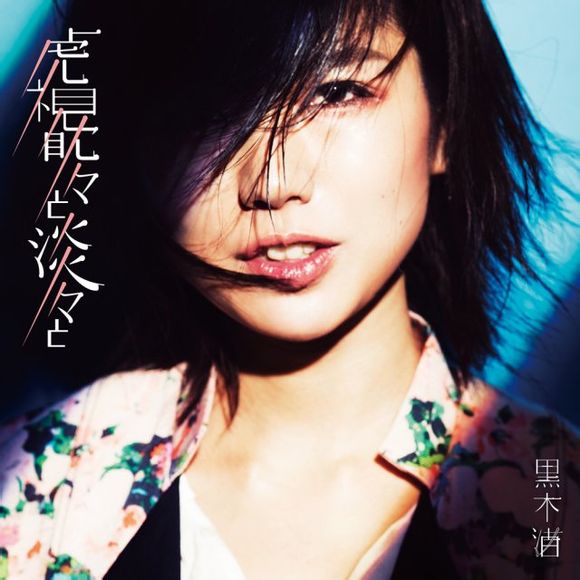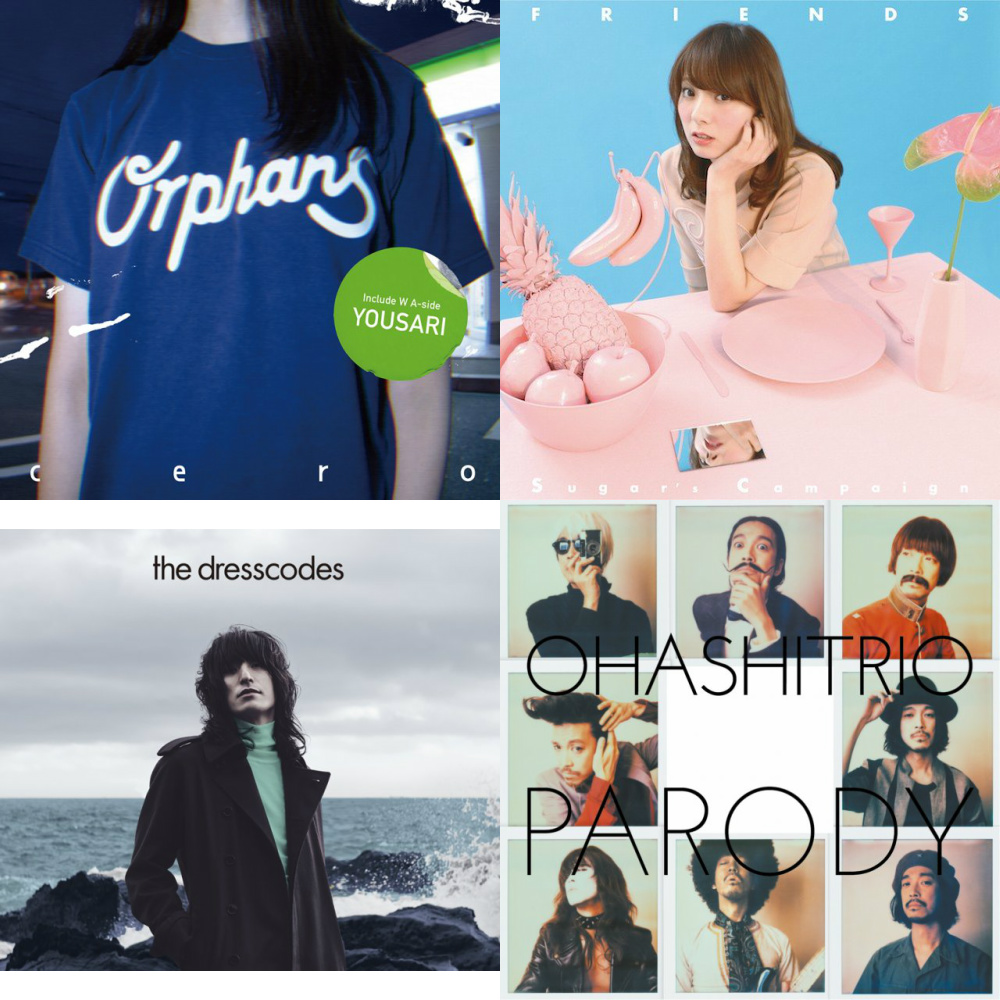Hello AramaJapan readers! After a brief hiatus, we are back with our monthly wrap up feature. A few of the staff members have come together to share their faves for the months of December and January. Find out what the staff was loving these past 2 months! Also feel free to post what you loved this past December and January in the comments!
December
Ronald
Various Artists – Utada Hikaru no Uta

I’m a big Utada Hikaru fan so I was interested in hearing this album as soon as it was announced. My anticipation grew once I found out that 3 of my favorites would be featured on the album: Ayumi Hamasaki, Shiina Ringo, and Kato Miliyah. The most surprising song on this album is actually Ayu’s:
This was the most hyped song on the album since Ayu and Utada share a long history as “rivals.” But the singers both share a mutual respect for each other. The song sounds very familiar but new at the same time. It’s a nice refresh. And Ayu’s vocals on here sound very emotional, there’s an urgency here that I really like.
In a surprise move, Miliyah covered “For You.” The thinking was that she would cover “Automatic” since she had just released it on her 10th anniversary album a few weeks earlier. I’m glad that her “Automatic” cover wasn’t included because this “For You” cover blows it out of the water. She kept the song the same but did freshen it up a little. Her vocals on this song are really good. The bridge using a little bit of “Give Me A Reason” was a nice touch. Miliyah being on this album made me think quite a bit about her career over the decade she’s been out. Utada is said to have picked the artists for this release herself because they were personal singer-songwriters that she respected. When Miliyah debuted, the media dubbed her the second coming of Utada because of her being a 16 year old high school student who wrote her own songs. By being picked for this album, does Utada in some way endorse this idea? I personally endorse it. I think Miliyah is probably one of the most underrated artists in Japan of the past decade.
Another surprise was Ohashi Trio’s cover of “Stay Gold.” I think I actually like this cover more than original. I’ve always loved “Stay Gold” and it’s always had a special meaning for me but this version is just so much more emotional. It takes me back to why this song became so special to me.
My only real complaint about this album is that we didn’t get a studio version of Ringo’s “Traveling” cover that I’ve been obsessing over for months.
cero – Orphans / Yousari

This is a really chill song; it has a really nice groove to it. It’s like a mixture of jazz and funk. It reminds me of something from the 70s for some reason, especially that catchy whistle part. It still sounds fresh though.
the dresscodes – 1

This is Shima Ryohei’s first release as the dresscodes. the dresscodes were originally a band but it is now Ryohei’s solo project. They really caught my attention last year with their release “Hippies E.P.” It was such a mix of sounds that worked well together. This album is much in the same vein. One thing I liked about the album is that even though all the other members of the band left, there wasn’t really any drop in the quality of the music. I admire that he is able to take this whole project on himself and have it turn as just as good as when he was in a band.
Ryusenkai
Singles:
FOLKS – Fuyu no Himawari

I’ve already spent a fair amount of time gushing over exactly why I love FOLKS in a previous Staff Selections post back in September, but this new song manages to both reinforce those feelings as well as give me hope for the band’s future. FOLKS’ first digital single and the lead track off of their upcoming mini-album “SNOWTOWN” (which is due out this coming week), “Fuyu no Himawari” sees them exploring a lusher, more expansive digital soundscape than they have for any of their songs in the past. This is helped in no small part by the song’s production, which is credited to Sunahara Yoshinori, a former member of influential techno group Denki Groove. There are a lot of layers to this track, from the twinkling and synths that are with us from the moment it begins to the natural sounds recorded from the group’s hometown of Eniwa in Hokkaido, with the band located neatly in-between these two extremes. What I think I enjoy most about the song though is the sense of progression that I get each time that I listen to it: there are playful moments where the drums and some sparkling electronics take the forefront, and there are likewise weightier moments where the electric guitar and lengthier synth passages get their chance to shine. The vocals are smooth and mesh sublimely with the background instrumental, strong enough to remain distinct yet never truly overpowering it. In the end, I think that everything comes together as the brilliant ode to winter that “Fuyu no Himawari” is intended to be; not only that, it’s also my favorite song released in December and something that makes me keenly excited to see what the rest of their mini-album has to offer.
cero – Orphans / Yousari

(See Ronald’s post above for video)
While “Fuyu no Himawari” might be my favorite song from December, my favorite single from the month is without a doubt cero’s unexpectedly brilliant Double A-side “Orphans / Yousari”. Prior to this release I’d actually never heard of the trio before, but their easy-going yet rich sound palette has definitely caught my attention; if I had to peg their genre, I think I’d describe it as jazz fusion with touches of indie rock and funk at just the right moments. The first A-side, “Orphans” indulges in these influences wholeheartedly, horns and groovy electric guitar joining with keyboard and whistle-like synths to create an alluring, danceable melody that brings to mind summer and island beaches. The singer’s vocals, while not perfect, have a warmth and camaraderie to them that add far more to the experience than they could ever take away (no matter how bad that falsetto is). “Yousari” puts the drums on more of a center stage with the horns and coats everything in a subtlely pulsing synth to create a slow-burning lounge track reminicent of some of Steely Dan’s back catalog, which in my eyes can only be a good thing. The lone B-side, “Hitotsu no Mahou (Owarinonai Itoshisa Wo Atae)” is a cover of a classic Ozawa Kenji song, and it shows in the more upbeat, funky melody punctuated by some well-timed interjections from the horn section and the vocal delivery (which is perhaps the most impressive out of any track on the single). If you like jazz and funk, then you’ll absolutely adore this single, and very luckily for me, I happen to love both.
Honorable Mention: Niiyama Shiori – Zettai
Albums:
Sukima Switch – Sukima Switch

From one jazz-fusion group to another, this one with some more pop sensibilities, Sukima Switch’s eponymous release (and their first full album in over three years) was something that I was looking forward to quite a bit in the weeks leading up to its release. Even though it was only going to be made up of ten tracks, fully half of which I’d already heard, I was interested in seeing how everything was going to come together as an actual album. In the end, I have to say that I’m kind of glad that the group stuck to such a lean track list, since it was trimmed of any fat or filler that could be found on a studio album and instead delivered a remarkably consistent experience that showed just what Sukima Switch were made of musically. Some particular highlights from the record are the unexpectedly aggressive pop-rock opener “Genome”, the mellow yet emotive jazz ballad “Boku to Kasa to Nichiyoubi”, the light-hearted, flute-driven “LifexLifexLife”, and the funky and synthy “Chouchou no Kona”. The mix of jazz with pop-rock provides a suitably diverse catalog of sounds for this release that’ll keep you guessing as to exactly what you’re going to hear next; so, if you’re in the market for an album that has an eclectic, well-executed mix of genres backed by vocalist with a voice that’s quite distinctive, then Sukima Switch’s latest might just be exactly what you’re looking for.
the dresscodes – 1

(See Ronald’s post above for videos)
A varied set of sounds is something that I believe my favorite album from December also possesses in spades. “1″ is the third full-length album by rock act the dresscodes, but is also the first release since all of its other members save the vocalist left the band; in other words, this is the first time where singer Shima Ryohei did everything from compose the music to record all of the instrumental parts himself. The result is perhaps one of the most impressive ‘solo’ efforts that I’ve seen come my way in 2014, with some of the most intriguing composition and vocal delivery to boot. That said, I’ll be upfront about the fact that Shima’s voice might take just a bit of getting used to, as it can get pretty darn nasily at some points. From the start of the record, you’ll be treated to such highlights as “Super, Super Sad” and “Lily”, a pair of tracks which have clearly been influenced by classic British rock, down to the mix of acoustic and electric guitars in the former and the upbeat piano driving the latter. These are followed by “Kono Akuma-me”, which mixes indie and classic rock sensibilities together and serves as a bridge between the first section of the record and the second, which houses such songs as the heavier, guitar-fronted “Rousseau-ron”, the unabashedly jazzy and bass-heavy “Anime Mitai na” (which is a particular favorite), and the psychedelic rock tinged lounge ballad “Mizuiro”. While there’s a lot of other great songs on the release, I’d also like to bring particular attention to the album’s closer “Ai ni Kiwotsukete ne”, which brings rock and various kinds of synths together for what can only be described as a cathartic release of emotion that you need to hear for yourself to understand. This is an album that due to its nature is somewhat difficult to describe in its entirety, but I hope that I’ve at least done a good enough job to convince some of you to give it a shot, since it really is worth your time. That I promise.
Honorable Mention: Brian the Sun – Brian the Sun
__________________________
January
Ronald
Sugar’s Campaign – FRIENDS

This is the first album by Sugar’s Campaign, a duo composed of electronic producers Avec Avec and Seiho. This album is somewhat different from their solo work in that it has much more of a throwback sound. Sugar’s Campaign’s sound is very much influenced by the sounds of the 70s and 80s, acts like Yamashita Tatsuro and Steely Dan. This album is a very feel good album but chill at the same time. Two of my favorite songs on the album represent these 2 moods of the album. On the upbeat side, there are songs like “Holiday”:
It’s a very upbeat, dancey song with a good amount of funk to it. Very euphoric. But then on the flipside, there are songs like “Hong Kong Seikatsu.” This song may very well be my favorite song so far this year. This song is just so smooth and lush, yet it still has that funky groove to it.
I find the timing of this album’s release to be very interesting. It’s been nearly 3 years since Sugar’s Campaign released their first song, “Netokano”:
In the time since then, Japan’s underground electronic music scene, the netlabel scene, has really gained traction. tofubeats, one of the leaders of this scene, released his major label debut last year, and now we have Sugar’s Campaign debuting on a major label too. Is this the next wave? Could we see the netlabel scene break into the mainstream much in the same way that there was an electropop boom last decade after Perfume’s mainstream breakthrough?
There’s also been a number of releases that borrow from the funkier sounds of yesteryear. This is one of them, as is the cero release from December that Ryusenkai and I selected. Could this be another wave as well? We shall see…
KOHH – Kuchinashi Ko

Last year was a banner year for Japanese hip hop. There were great releases by the likes of SALU, KLOOZ, AKLO, JAZEE MINOR, ANARCHY, and maybe most surprisingly KOHH. KOHH was kinda thought of as a joke, but last year when he made the jump from mixtapes to albums, he really came into his own. “MONOCHROME” was a really good album. It showed a lot of development. That album was actually KOHH’s second recorded album but his first released album. He decided to release it first for unknown reasons. On New Year’s Day, he finally released his first recorded album, “Kuchinashi Ko.” Listening to this album, you can really see that bridge between his mixtapes and “MONOCHROME.” It all kinda makes sense. There are some songs from his mixtapes but there are some new songs as well. The standout track for me is “Where You At”:
This song really surprised me. It’s like a softer, more romantic side of KOHH. It really shows his versatility.
The timing of this album’s release really couldn’t be any better. KOHH’s kinda gone viral recently in Western hip hop circles. He was featured on Korean rapper Keith G’s song “It G Ma”:
This song went viral in Western hip hop circles. It then led people to look up more information on KOHH. He was a trending topic on Twitter under the hashtag “The Chief Keef of Japan.” A Vine video of his part in the song “HIROI SEKAI” has got more than 4 million loops on Vine in a little under a month:
This attention isn’t lost on KOHH though. He knows it’s happening. That is why he’s recently been releasing English subbed music videos, including one for his new album’s opening track, “Hikoki”:
I’ve been a fan of J-Urban since I got into Japanese music (I got into Japanese music right before J-Urban hit its peak last decade). I’ve always felt that it could get some attention in The West and it finally is. The funny thing about Asian music and Western attention is that the things you don’t expect to get the attention, end up getting the attention.
Ryusenaki
I’m just going to preface my recommendations for this past month by saying that I think this January has genuinely been one of strongest music-wise in years; there was so much good music released that it’s going to be hard to even pack in everything that I want to, but I’m going to do my level best. So, let’s get started!
Singles:
Yonezu Kenshi – Flowerwall

If nothing else, Yonezu Kenshi is definitely one of the more unconventional acts to find their way onto the scene in recent years; to go from a vocoloid producer to a pop/alt rock musician fronted by his own voice is a pretty big change, in all honesty. Still, I expect that it’s these origins which have given his music something of a unique flavor among the rest of the other male soloists out there. “Flowerwall” is Yonezu’s first single since he released his second full album “YANKEE” in April of last year, and given how intriguing and off-kilter a release that was, I was quite interested to see what he’d be bringing to the table this time. The title track is at first listen a surprisingly sparse pop-rock number, though there a few interesting and subtle tricks being done with electric guitar and synth if you pay careful attention. Still, the star of this song is definitely meant to be Yonezu’s vocals, which in this case are (at least to me) oddly reminicent of RADWIMPS’ frontman Noda Yojiro’s. Thankfully, I really like Noda’s voice, so even though the arrangement itself is a bit bare, I do enjoy the performance for what it is, though I think that the choral layering used on the track is just a little unnecessary personally.
The most interesting pieces of this single are definitely the B-sides though, since that’s where Yonezu seems to start experimenting with some sounds that are out of his traditional wheelhouse. “Zange no Machi” sees the choral effect I complained about above far more comfortably at home, the melody of this funky and adventurous rock track led by wailing electric guitar and rollicking acoustic guitar. Once again I have to compliment the layering used here, since there are a lot more moving parts to this song than there were to “Flowerwall”, and yet everything seems to have its place in the overall mix. It’s rare that I compliment drumming, but I actually will do so here, since it manages to both drive the track forward and add to the overall sound texture without being too obtrusive on its own. It’s the second B-side that’s truly out there though; “Petrichor” is something that I can best describe as a haunting and oppressive mix of rock and R&B, strange as that might sound. Yonezu did something a bit similar to this with “Karma City” on his last album, though I’d still say that this particular piece of work remains fairly unique among the rest of his discography. For the first time, the more traditional band instruments are swallowed up by a synth soundscape, though they can absolutely still be heard if you listen carefully. I’ll honestly admit that I’m surprised by how well his voice seemed to work for this kind of song, since it’s something that didn’t really click until I heard his first bar. On the whole, “Flowerwall” was a very, very interesting single, even if the lead track is just a tad underwhelming.
Kuusou Iinkai – Kuusou Katakoi Makuranosoushi (EP)

Kuusou Iinkai are an up-and-coming band that I’ve been watching for a pretty good number of months now, since I could tell that they were going to release something that was going to really impress me eventually. It looks like that’s happened sooner rather than later, since “Kuusou Katakoi Makuranosoushi” really is quite the nice piece of work. Opener “Haru Koi, Kakumei” is energetic right out of the gate, a series of intertwined electric guitars quickly launching into a barrage of sound that makes up much of the body of this track. This is yet another case where the drums are particularly present, the sheer force behind them punctuating every last bit of of the instrumental, and at times almost seem to mesh with the vocals from singer Miura Ryuichi. Miura has a forceful voice with a uniquely smooth texture that allows him to project without ever sounding strident, which works perfectly when it’s overlayed over a wild composition like this one.
The second track on the CD, “Sakusen Chord:Natsu Matsuri” turns down the energy just a little, filling that missing hole with some funk and plenty of attitude. One of the electric guitars is still carrying the melody, and if anything sounds even heavier than it did on the previous song, though it sounds like just a few math rock-esque elements have been mixed in to vary things up. As before, Miura’s vocal delivery is excellent, and adapts perfectly to the change of tone that takes place from the get-go in this song. “Aki Kure Time Capsule” puts on the brakes even more and focuses more on the drums and bass for the majority of the verses, with the electric guitars only really playing a major role in the chorus and the bridge (where you really can appreciate just how nice and lyrical the melody for this track is). By the time we reach the winter song on this seasonal tour de force, we’ve slowed considerably from our initial velocity and have actually encountered an intro that’s comfortably mellow, though it picks up just a bit following this. “Muffler Shoujo” is a sweet ode to the season and the way that it makes people dress, set to the tune of a more understated electric guitar and the clearest vocals we hear from Miura the entire record. It’s a fitting closing song, and I think manages to tie up this particular release rather neatly.
Kuroki Nagisa – Koshitantan to Tantan to (EP)

What’s this? A female soloist has my favorite single of the month? Rare though it might be, Kuroki Nagisa is definitely one of the members of that category whom I find to be intriguing enough that I always keep an eye out for when she’s releasing something new. This EP admittedly crept up on me though, since I wasn’t even able to find much information about it until the week it released, and then I had to scramble to find it and see what I’d been missing. The lead song “Koshitantan to Tantan to”, regardless of how ridiculous the title might sound (it actually translates to something along the lines of “Watching Vigilantly and Indifferently and”), is a string and bass-driven pop rock track that plays to the strengths of Kuroki’s strong and sharp voice, the backing piano, drums, and surprisingly subtle electric guitar filling out the melody into a pleasantly wide cathedral. It’s just a tad reminicent of the opener from her album last year (electric guitar is a lot more prominent in that one), though I think stands apart enough to be considered a solid and enjoyable piece of work on its own.
“Picasso” is a song centered around the piano and drums, a light-hearted and fun melody dominating for the vast majority of its length, complete with whimsical backgrounds sounds (there’s even a classical interlude towards the end). This is one of those tracks that I think best shows off just how pleasant Kuroki’s vocals can sound when she wants them to, since she’s all smooth, no edge in this particular case. “Youkoso Sekai e” is a bit more of a rocky track, the electric guitar and some synths handling most of the melody and the drums and bass taking support; it’s actually my favorite song on the EP, since it mixes the driving force behind the first song with the abandon found on the second in just the right measures so that one doesn’t overpower the other. We close with “Daihonmei”, which is perhaps the first time that we really slow down on this record, Kuroki choosing to take a more acoustic approach and soothe rather than push with her voice. It’s a short, sweet finish to what really is a great release when considered together, and something that I can’t recommend giving a try enough.
Honorable Mentions: Superfly – White Light, B’z – Uchouten, Nothing’s Carved In Stone – Gravity
Albums:
KANA-BOON – TIME

Going into January, I’d say that KANA-BOON’s second studio album was probably the release that I was looking forward to the most, since they’d had a very respectable set of singles in 2014 and looked to be a band that was definitely on the rise. While it didn’t actually end up as my favorite album for the month, that in no way means that “TIME” is a bad album or anything of the sort. In fact, it’s actually a very good release, provided that you don’t mind the fact that it isn’t as aggressive a record as their first album was. That’s not to say that there aren’t energetic and in-your-face moments (“LOL” and “Klaxon” in particular come to mind), but “TIME” definitely sees the band exploring different areas of their sound than just that. The result is what I think is a more multifaceted record than “DOPPEL”; one that has rises and troughs and goes through a number of different moods before it finally reaches its conclusion.
Some favorites from this album for me are “Terminal”, whose tempo-shifting and and faint choral vocals manage to create a surprisingly interesting interplay between each other, the aforementioned attitude-filled “Klaxon”, the confrontational, guitar-fronted “Full Drive”, the uncharacteristically somber and melancholic “Ai ni Mamirete” (which might be my actual favorite), and the bright, hopeful closer “Parade”. If you’re a fan of indie rock, then “TIME” is an album that I very much recommend taking a good look at, since you really don’t know what you’re missing.
Tokunaga Hideaki – VOCALIST 6

If I’m remembering correctly, this is the first time that I’ve placed a cover album in my recommendations for a month, and trust me, I actually have a very good reason for this one. Tokunaga Hideaki is perhaps one of the artists most famous for his cover work, as his VOCALIST project is actually surprisingly focused: he’ll only cover songs by famous female singers, and even among those he’s very careful about his selections for each particular release. There’s an attention to detail that goes into each entry of this series which I only very rarely see in other cover albums. As a result, “VOCALIST 6″ feels a lot more like a studio album on a listen through than it does a collection of covers, as there’s a clear flow to it, whether this be because of the track order, the new arrangements, Tokunaga’s production, or any combination of those three. This, combined with what can only be called an utterly superb vocal performance and a unique old school take on many of those tracks, makes for an experience that you’re not going to find in too many other places these days, and an especially quality experience at that.
I honestly love just about every song covered on this record, but to name a few that I really enjoy: the halting, emotive take on Yamaguchi Momoe’s “Sayonara no Mukougawa”, the light and airy version of DREAMS COME TRUE’s “Thank You”, the lonely jazz of Nakamori Akina’s debut hit “Slow Motion”, the classy pop of Candies’ “Yasashii Akuma”, and the somber beauty of Matsutoya Yumi’s “Dandelion ~Osozaki no Tanpopo”.
Ohashi Trio – PARODY

Much as I do love “VOCALIST 6″, the album that I think I enjoyed the most in January, and the one which I’m proud to call my favorite from that month is Ohashi Trio’s “PARODY”. For those who don’t know, Ohashi Trio is the solo project of multi-instrumentalist and composer Ohashi Yoshinori; in other words, pretty much everything that you hear on this record is the work of him and him alone, which is impressive to start with. The main genres that Ohashi tends to work with for this project are jazz and funk, though there are certainly shades of other styles, like pop and folk, that show through over the course of his work and this album in particular. That said, what I think makes “PARODY” stand out from a lot of other albums in that vein is that despite indulging so very much in the sensibilities of jazz, it almost always seems to remain accessible to those outside of that particular niche (or so many of those I’ve given it to have told me). Since I really like jazz, I can’t really describe why this is so, though I think that it might have something to do with the inclusion of more poppish melody lines on a good amount of the songs. Whether it’s the incredibly fun and wild title track “PARODY”, or the subtlely rock-influenced ballad “Haiiro no Sekai”, this appears to remain true.
For favorite songs off of this record (while I again do like all of them), there’s the aforementioned “PARODY”, the smooth and jazzy “Cherry Pie”, the folksy and sentimental “Mekurumeku Bokura no Deai”, the funky and slick “game over”, and the piano-infused Latin flavor of “Circus Koya”. This is an album that I really recommend that people at the very least give a try, since you might just find that you like it more than you’d expect.
Honorable Mentions: LAMP IN TERREN – silver lining, Itsue – Konya Zettai, The Cheserasera – WHATEVER WILL BE, WILL BE, Sugar’s Campaign – FRIENDS (This was a narrow miss, and really is a wonderful modernization of the city-pop sound that’s worth trying if you enjoy things in that vein.)

Comments